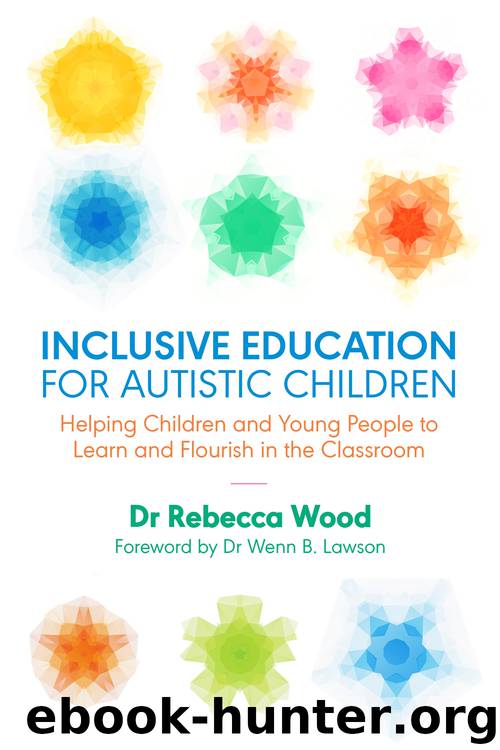Inclusive Education for Autistic Children by Rebecca Wood

Author:Rebecca Wood
Language: eng
Format: epub
ISBN: 9781784506346
Publisher: Jessica Kingsley Publishers
Published: 2019-07-01T16:00:00+00:00
Writing
All of the children in my cohort struggled with writing, either in terms of the content of the topics they were asked to write about, or the physical skills required. Even the sole child who enjoyed writing activities – the only girl in the pupil cohort – found written tasks time-consuming and effortful. It is perhaps unsurprising therefore, that at Key Stage 2, autistic pupils lag even further behind in the statistical averages, with only 35 per cent reaching the expected standard in 2016, compared with 74 per cent for all pupils (DfE 2017a).
One issue was the nature of what the children were expected to write about. For some, a strong preoccupation with a particular interest meant it was difficult for teachers to get them to write on other topics. Similarly, Williams (1992/1999, p.55) stated that in English, she would write, ‘though never on the prescribed topic’. In addition, and although this was not the case for all, open questions of the ‘Describe your perfect weekend’ variety were found to be especially problematic, as were those aimed at encouraging some sort of creative expression.
Story writing: imagining and making up a story with no direction (was difficult). I found a blank piece of paper and the instruction ‘use your imagination’ ridiculous. At that age I couldn’t see the point. (Kabie)
It is perhaps worth remembering that while it is important to encourage creativity in school, not all children have an inner poet waiting to burst forth. Some find beauty in details and facts, not fiction, and so the sort of writing some autistic children produce deserves to be credited with its own aesthetic, rather than measured against a narrow conceptualisation of what constitutes imaginative work.
However, it was the physical, motor skill of writing that the autistic children in my study found the most difficult (Kushki, Chau and Anagnostou 2011). Yet only two of the children, including a boy who had an additional physical disability, received support from an occupational therapist, and the extent to which this input was targeted at their difficulties with handwriting was not clear in any case. On other occasions, autistic children educated separately from their cohort were expected to write in cramped spaces, or on tables that were either too high or too low (unlike the tables and desks in their classroom), or even on the floor, creating yet more disadvantage in an area where they were already struggling. Support staff also alternated between placing pens in the child’s right and left hand, without having identified which one the child preferred to use.
Moreover, if differentiated Maths exercises were sometimes repetitive and uninspiring, this problem also applied to a small number of writing exercises I observed. Tasks of zero educational value, made up on the spot, consisting predominantly of monotonous, rote copying, were evident, creating significant demoralisation on the part of the child, and even distress.
Download
This site does not store any files on its server. We only index and link to content provided by other sites. Please contact the content providers to delete copyright contents if any and email us, we'll remove relevant links or contents immediately.
| Behavioral Disorders | Communicative Disorders |
| Gifted Students | Inclusive Education |
| Learning Disabled | Mentally Disabled |
| Physically Disabled |
The Art of Coaching Workbook by Elena Aguilar(51083)
Trainspotting by Irvine Welsh(21573)
Twilight of the Idols With the Antichrist and Ecce Homo by Friedrich Nietzsche(18572)
Fangirl by Rainbow Rowell(9180)
Periodization Training for Sports by Tudor Bompa(8217)
Change Your Questions, Change Your Life by Marilee Adams(7690)
This Is How You Lose Her by Junot Diaz(6837)
Asking the Right Questions: A Guide to Critical Thinking by M. Neil Browne & Stuart M. Keeley(5712)
Grit by Angela Duckworth(5557)
Red Sparrow by Jason Matthews(5429)
Paper Towns by Green John(5141)
Room 212 by Kate Stewart(5073)
Ken Follett - World without end by Ken Follett(4688)
Housekeeping by Marilynne Robinson(4399)
The Sports Rules Book by Human Kinetics(4348)
Double Down (Diary of a Wimpy Kid Book 11) by Jeff Kinney(4244)
Papillon (English) by Henri Charrière(4229)
The Motorcycle Diaries by Ernesto Che Guevara(4054)
Exercise Technique Manual for Resistance Training by National Strength & Conditioning Association(4023)
